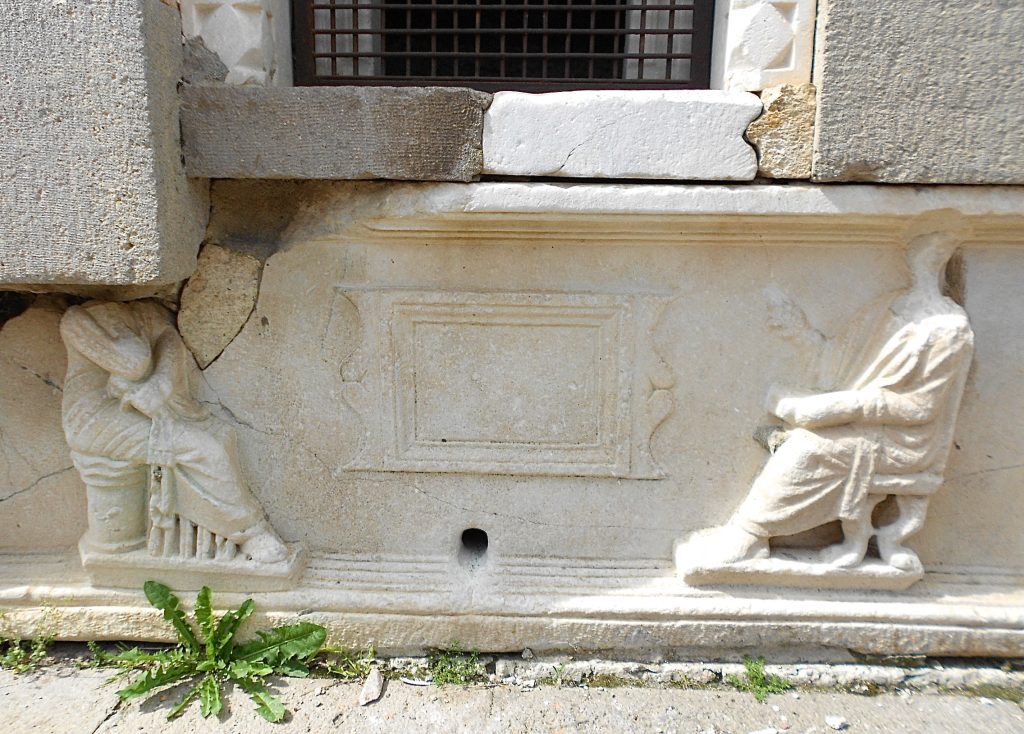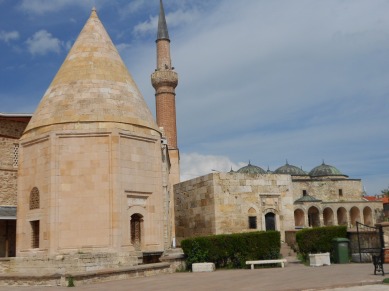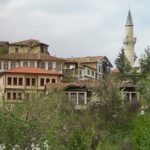“City of the Bey” Population: 29,000
Market day: Tuesday
Given that Lake Beyşehir is not just the largest expanse of water in Turkey’s Lake District but also the largest freshwater lake in the whole country, it would be easy to assume that it would have a thriving tourism industry. However a dramatic mountain backdrop and twin islands prettily linked by causeway to the mainland have given smaller Lake Eğirdir, to the west, the edge when it comes to attracting visitors. Most people whip past Beyşehir town on their way from Eğirdir to Konya without ever leaving the bus. In doing so they probably don’t realise that they are throwing away the chance to visit one of Turkey’s finest surviving historic mosques.
Lake Beyşehir is at its most beautiful in early evening when locals take a turn along the promenade to watch the sun set over Mt Dedegöl (2998m). Standing on the shore it’s just about possible to make out several small islands “floating” above the water. Some of these islands vanish in years of exceptionally high rainfall, which means that there is no agreement as to exactly how many of them there are (30+ by most counts). A few were once home to Byzantine monks.
Around town
The wondeful Eşrefoğlu Camii is beautifully situated a short walk inland from the lake. It was built in 1299 for Eşrefiye Seyfeddin Süleyman, one of the Eşrefoğlu dynasty that ruled this part of western Anatolia from 1277 to 1326 during the period of the beyliks (principalities) that followed the collapse of the Selçuk Sultanate of Rum (hence the name Beyşehir — “City of the Bey”). Not much is known about this man who must have had an ego comparable to that of Antiochus I of Commagene, the king responsible for the famous tomb and temple on top of Mount Nemrut. However thanks to him modern visitors are able to see a magnificent example of what is sometimes rather fancifully called a “forest mosque”.
The Eşrefoğlu Camii is the exact opposite of the famous mosque at Divriği, which puts on such a flashy outward display of carved masonry. At Beyşehir there is little externally to hint at what lies within, which makes it all the more remarkable to step inside and find yourself in a huge, light hall whose flat, painted ceiling is supported by 42 soaring wooden columns (hence the “forest” imagery). Until recently the sense of light and space was all the more striking because the centre of the mosque was open to the heavens via a skylight, called a karlık. Unfortunately, modern mosque-goers value warmth above antique charm and so the karlık has had to be glassed in.
Until recently the sense of light and space was all the more striking because the centre of the mosque was open to the heavens via a skylight, called a karlık. Unfortunately, modern mosque-goers value warmth above antique charm and so the karlık has had to be glassed in.
Few mosques in Turkey still glory in such a wealth of woodwork — in the rafters, the columns, the capitals, the mimber (pulpit) and the galleries. There are even vast wooden platforms on which, presumably, the Bey and the muezzins would have been seated. Only the mihrab breaks out of the wooden mould, providing a superb display of elegant Selçuk tiles in turquoise, blue and black.
Not surprisingly when he died in 1302 Eşrefiye Seyfeddin Süleyman did not want to be buried far from his masterpiece and his lovely tiled tomb is tacked onto the side of the mosque. It’s normally kept locked.
In 2023 the Eşrefoğlu Cami became a world heritage site in a group with other ‘forest mosques’ in Sivrihisar, Afyon, Ankara and Kasaba.
Immediately behind the mosque but easy to overlook is the İsmail Ağa Medresesi built for an Ilhanid leader in 1369 and in use right through until 1912. Its main entrance has the magnificent decor that was the hallmark of the Selçuks.
Here, too, are several other interesting medieval buildings, including the multi-domed Dokumacılar Hanı (Weavers’ Hall) and the remains of a double hamam dating back to the mid-13th century.
In the streets around the mosque you can still see examples of old Beyşehir houses, albeit mainly in a very poor state of repair. Downhill from the Dokumacılar Hanı there are also remains of the Kale Kapısı, a Selçuk gate erected c. 1288-90, and a small section of the city wall. Part of the wall has now been completely rebuilt.
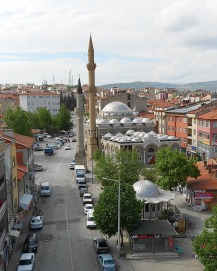 Modern Beyşehir has been severed from its historic core by a busy main road and has little to say for itself. The modern town, centred on the modern Cuma Cami with a single minaret from an earlier incarnation standing orphaned beside it, is not particularly exciting.
Modern Beyşehir has been severed from its historic core by a busy main road and has little to say for itself. The modern town, centred on the modern Cuma Cami with a single minaret from an earlier incarnation standing orphaned beside it, is not particularly exciting.
The large Taş Köprü (Stone Bridge) that regulates the flow of water from the dam is striking and impressive. It was built between 1908 and 1914 as the dying Ottoman state’s first attempt at a dam project. The channel behind it is lined with teahouses which make pleasant places from which to appreciate the power of the rushing water.
Especially in early evening it’s fun to stroll along the lakeside promenade, looking out for great crested grebes and coots swimming close to shore. In lieu of a proper museum pieces of carved marble from Beyşehir’s past have been given a home in the waterside park. Pleasure boats wait to take you out onto the lake. There’s not much to see and something of a party atmosphere but the tickets are cheap and it’s a nice way to while a way an hour before dinner. There are also pedaloes for hire.
Sleeping
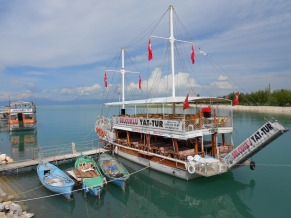
Anemas Hotel. Tel: 0332-511 0511
Star Pension. Tel: 0332-511 0222
Çankaya Pension
Transport info
Hourly buses link Eğirdir to Konya via Beyşehir, which means that you can stop to see the mosque and then continue your journey in either direction. Alternatively you can make a day trip from Eğirdir.
Beyşehir otogar is a 15-minute walk from the town centre. It is hardly a bustling places with almost no buses serving the settlements around the lake. The only really frequent service is the minibus to Konya which leaves the otogar every half-hour.
A handful of village dolmuşes leave from near the Taş Köprü but they’re not timed to suit day trippers.
The nearest airport is near Isparta.
Day trip destinations
